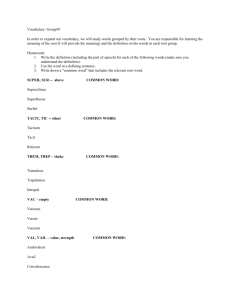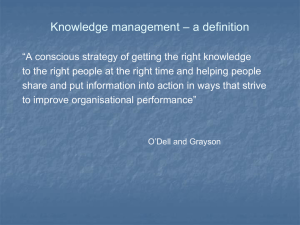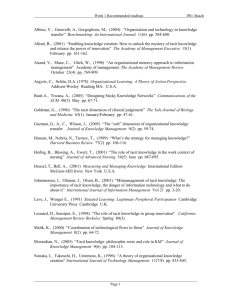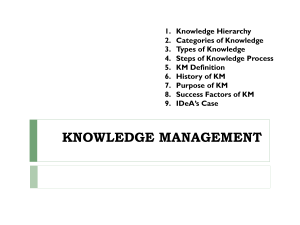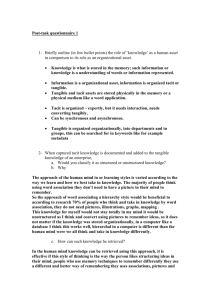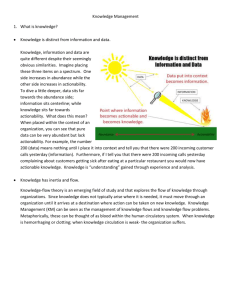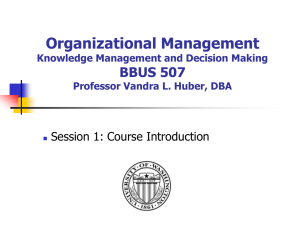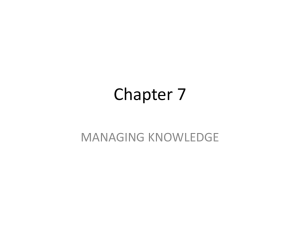11.329 Social Theory and the City Instructor Background:
advertisement
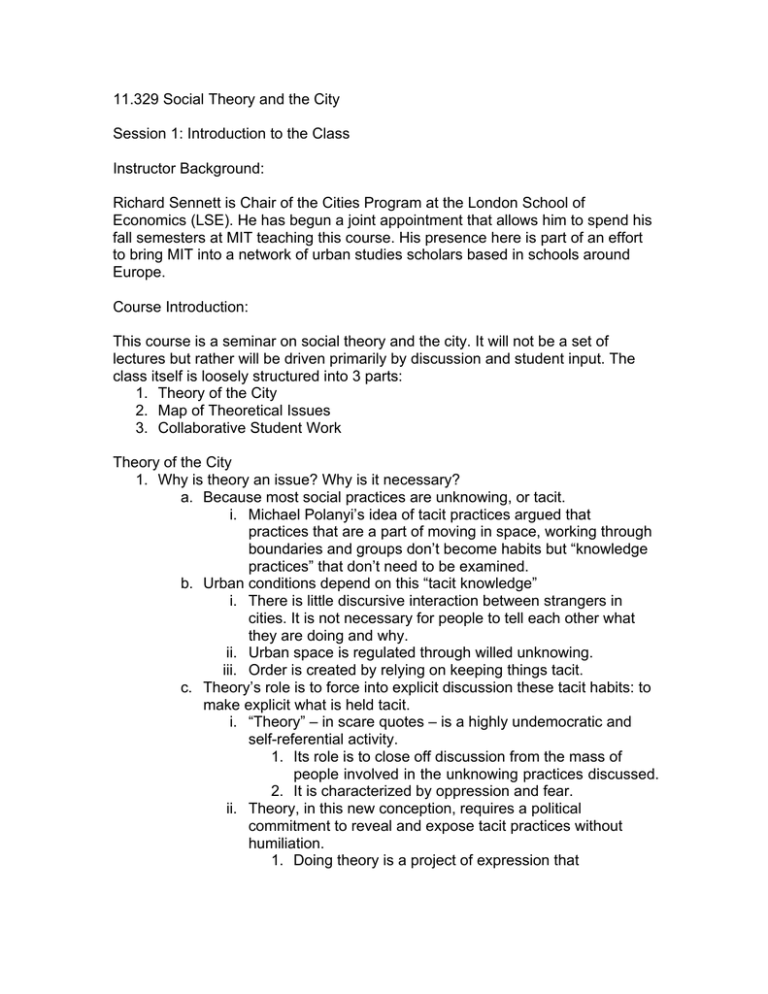
11.329 Social Theory and the City Session 1: Introduction to the Class Instructor Background: Richard Sennett is Chair of the Cities Program at the London School of Economics (LSE). He has begun a joint appointment that allows him to spend his fall semesters at MIT teaching this course. His presence here is part of an effort to bring MIT into a network of urban studies scholars based in schools around Europe. Course Introduction: This course is a seminar on social theory and the city. It will not be a set of lectures but rather will be driven primarily by discussion and student input. The class itself is loosely structured into 3 parts: 1. Theory of the City 2. Map of Theoretical Issues 3. Collaborative Student Work Theory of the City 1. Why is theory an issue? Why is it necessary? a. Because most social practices are unknowing, or tacit. i. Michael Polanyi’s idea of tacit practices argued that practices that are a part of moving in space, working through boundaries and groups don’t become habits but “knowledge practices” that don’t need to be examined. b. Urban conditions depend on this “tacit knowledge” i. There is little discursive interaction between strangers in cities. It is not necessary for people to tell each other what they are doing and why. ii. Urban space is regulated through willed unknowing. iii. Order is created by relying on keeping things tacit. c. Theory’s role is to force into explicit discussion these tacit habits: to make explicit what is held tacit. i. “Theory” – in scare quotes – is a highly undemocratic and self-referential activity. 1. Its role is to close off discussion from the mass of people involved in the unknowing practices discussed. 2. It is characterized by oppression and fear. ii. Theory, in this new conception, requires a political commitment to reveal and expose tacit practices without humiliation. 1. Doing theory is a project of expression that a. Puts an enormous burden on the person doing it, and b. Creates a profound ethical / political dilemma: How do you theorize – make explicit that which is tacit – without humiliating those who are engaged in the unknowing, tacit practices? Mapping Urban Theory (as it now exists) 1. The discourse about what cities are in terms of social and political theory is only about 1 century old. a. Though cities are thousands of years old, changes in the last century meant that modern cities have no real reference in terms of scale and politics to what had come before. 2. Part 1: 3 schools of urban studies took form over the century: a. The Berlin School i. Max Weber, Georg Simmel (T.A. to Weber), and Walter Benjamin ii. Not marked by one shared philosophical pre-supposition iii. The experience of Berlin itself gave rise to 3 sets of foundational problems: 1. Weber: The relationship between urban places and the status of law. c. Rights and place are tied to cities. 2. Simmel: The city as a point of reflection of sociology 3. Benjamin: The city as a site for thinking about narrative cultural practices and narrative imaging. b. The Chicago School (at the University of Chicago before WWI) i. Founder: Robert Park, a journalist who studied with Simmel in Germany. Included Louis Wirth and Ernest Burgess (who generated the study of urban ecology) 1. The School looks at the spatializing of social and economic differences. 2. Its theoretical proposition: How territory cuts loose from natural difference; how social and economic differences are imposed on the natural geography of the place; how traditional ideas in social / political theory get instantiated. c. The Paris School (1950s – 1970s) i. Major players : 1. Henri Lefebvre – tried to create democratic socialism using the city as a space of production ; 2. Guy Debord and the Situationists – a rebellion against the Communist left ; 3. Michel de Certeau – a priest who passed through the Communist party ; and 4. Michel Foucault – a deeply anti-Marxist thinker. d. All were recovering from Marxism and its inability to address the condition of the city. i. All three schools have focused more on space than on built form (i.e. they are more about geography than architecture). ii. They attempt to imagine the city as space, not solid substance. iii. They have exhausted this path of inquiry. b. A new line of inquiry can now be opened that deals not with space, but with built form. i. Its questions include: 1. What is a just factory office? 2. What is a school building that improves education? 3. What is a democratic window? ii. In my own work, I am trying to deal with how theory can deal with things rather than location. iii. If the last century of thinking has been characterized by the tendency to dematerialize the city, disembody it, this new project aims to rematerialize our understanding of cities by focusing on built form. 3. Part 2: Cities have best engaged 4 types of theorizing: a. Marxism i. It makes claims about the material word that social scientists must take seriously (unlike Adam Smith’s theories, which focused on process) ii. Its irony is that while it provides an analysis of what goes wrong in the capitalist city, it does not provide any vision for an ideal Communist city iii. The emergence of Post Colonial theorists in the 1960s who equated cities with colonization short circuited Marxist theory away from the idea of the cosmopolitan as a project for Communism b. Public Realm Theory i. 3 versions of the public realm: 1. Juergen Habermas (derived from Weber): the public realm is constituted by the ways people reason about their social/economic/gender/etc. status. 2. Hannah Arendt: eschews the notion of identity in the city. The city is a place where people ideally ought to be equal because they are strangers to one another. Actual identity is unknown, so it should not bring about inequalities in the public realm. 3. Walter Benjamin: A dramaturgical approach to the public realm that emphasizes the conditions under which strangers become expressive to one another in crowds. The public realm is a place of presence and display rather than a place of decision making. c. Difference Theory ii. Deals with the question “How can we get unlike people to share a common culture?” iii. Pierre Bourdieu: The process by which people distinguish themselves is a kind of constructivism, an act of establishing inequality and contest. 1. “The Misery of the World” is a study of how people at the bottom of the economic ladder use the built environment to distinguish themselves culturally. d. Critical Realism – The Frankfurt School i. Walter Benjamin: The city offers a space of display that invites the eye to criticize. 1. The data we have for a critique of society must be displayed in some imagistic form such that the image is the site for criticism of the city. ii. Foucault takes this up and subverts it by claiming that the eye is incapable of functioning as a critical organ. e. Two additional movements are relevant but haven’t been taken up by sociology: i. Natural Communities Theory (Biology) 1. Founder: Humberto Maturana 2. Emphasizes the natural world of the city and the ecology of man-made communities 3. It is currently highly biological and not yet taken up by sociologists ii. Narrative Theory (Humanities) 1. When we talk about the relationship between time and place, time has no agency in telling stories, i.e. no person or persons are active in the telling. Collaborative Student Work 1. This course is intended to teach students not simply how to read theory and discuss theorists as subjects, but rather to help them develop themselves as thinkers and writers. a. We will use this seminar as a workshop for students’ works in progress. i. We will work out the theoretical implications of each other’s work as a group ii. We will function as a workshop rather than a lit review b. We will grapple with what is theoretically at stake: i.e. how do you move from a theoretical proposition into the realm of cities? 2. I would like to get the seminar involved in the network in Europe as well. Students should remain connected to this group even after the semester is over. 3. The purpose is to enable the current generation of urbanists to become public intellectuals through: a. Communicating with others b. Learning to be collaborative rather than competitive c. Learning how to be colleagues
